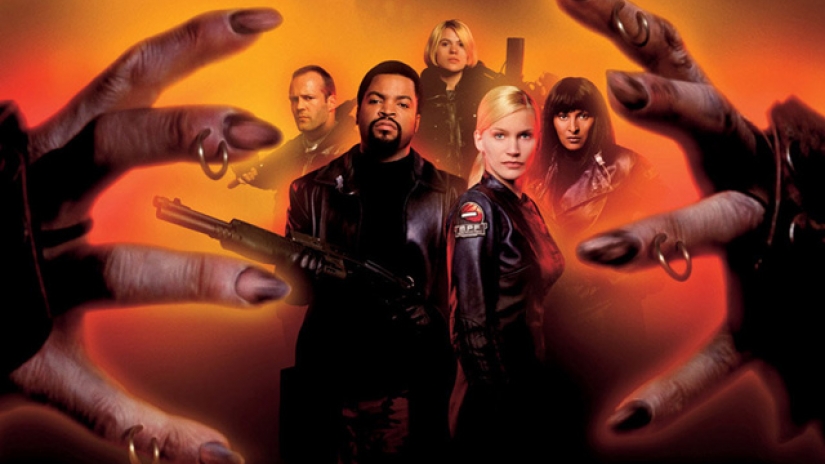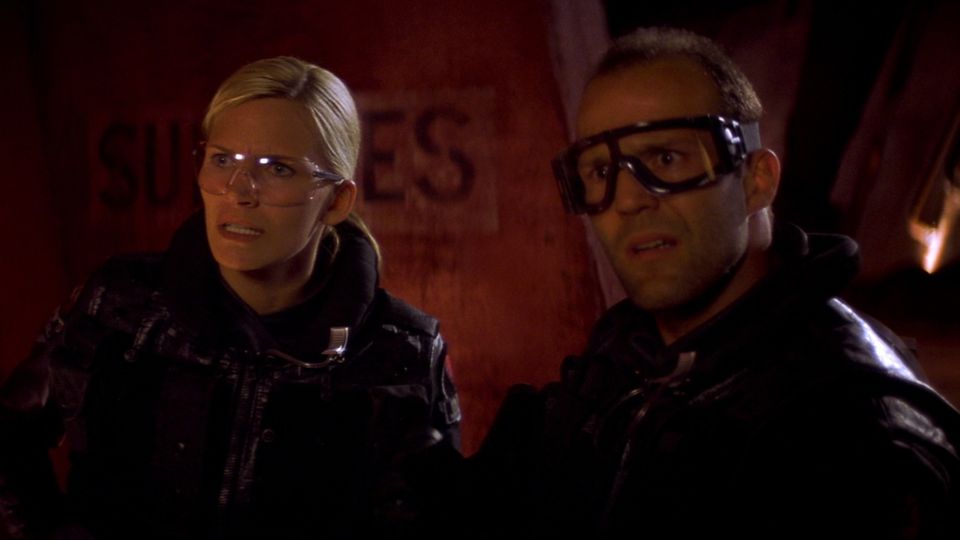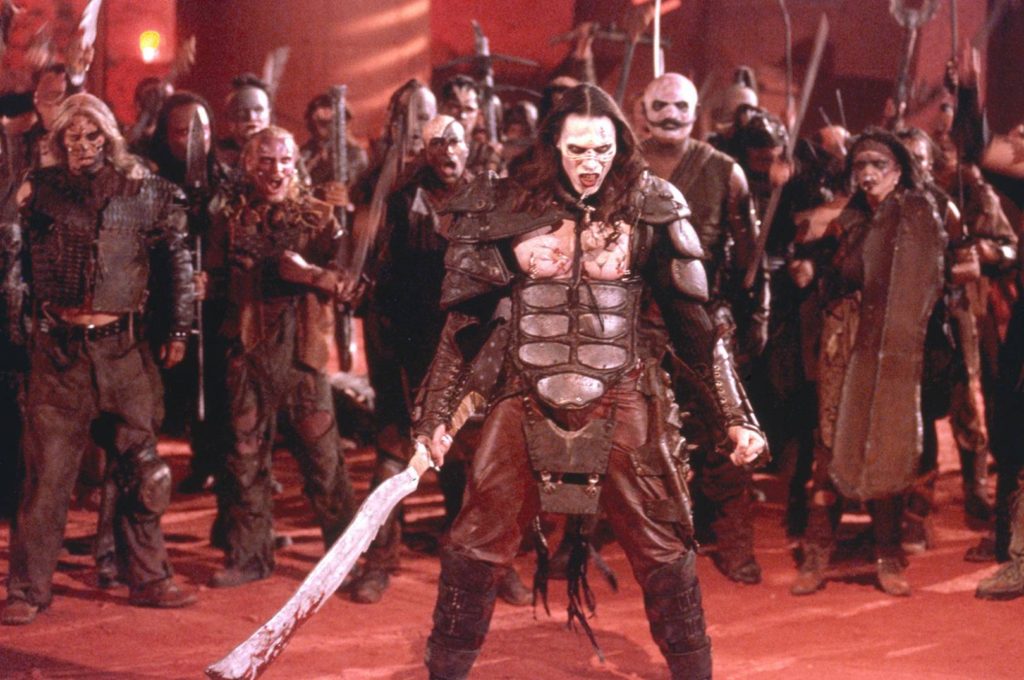
Hey, it’s John Carpenter’s birthday! Why not celebrate with one of the legend’s most critically-panned films?
We all know John Carpenter as the filmmaker who brought us some of the most lovable characters in cinema, like Michael Myers, Snake Plissken, and the evil sorcerer from Big Trouble in Little China. Not to mention he authored one of the best movie quotes of all time in They Live (a film I’ve discussed on our podcast before). Yet while most sane cinephiles have seen Halloween and The Thing multiple times, some of the writer-director’s other works have fallen under the radar.
Among these is the 2001 sci-fi/horror flick Ghosts of Mars, starring Natasha Henstridge and Ice Cube. With a 35% rating on Metascore and a 4.9/10 average rating among IMDb users, the film flopped when it came out and time clearly hasn’t helped boost its reception. Budget-wise, it took an estimated $28,000,000 to make; it only grossed $8,434,601 in the US. Poor Mr. Carpenter was so burnt out after making it that he took a nine-year hiatus from Hollywood, returning in 2010 to direct The Ward.
Yet despite its status as a financial and critical failure, Ghosts of Mars is one of the last films to employ Carpenter’s inexplicably rich aesthetic. Today, there are those who try to mimic the likes of Carpenter, Wes Craven, Sam Raimi and Paul Verhoeven, but who do so with a falsified sense of fan-service and some truly nefarious CGI. Though made at the dawn of the 21st century, Ghosts of Mars has the 80s and 90s written all over it. The cops and criminals join forces to defeat the aliens, the violence is relentless and exaggerated, and the Martian leader is a replica of the lead-singer from KISS. And of course Carpenter did the soundtrack, in addition to co-writing and directing the film.
I’m not going to argue that Ghosts of Mars isn’t a ridiculous movie with flat characters and a lot of bizarre storytelling choices. It’s a B-movie through and through. What I will argue is that the movie deserves recognition for its stylistic action and filmmaking technique, and that it’s well worth checking out.
Set 200 years in the future, the film opens with its protagonist, Lt. Melanie Ballard (Henstridge), reporting to her superiors about her most recent mission on Mars. In this universe, Mars is now a human mining colony. When Ballard and her crew arrive, they find it deserted except for a notorious criminal named Desolation Williams (Cube). Williams informs the crew that they’re all going to die there, prompting them to explore this mysterious wasteland.

What they discover is that the miners opened some sort of Martian construction in the soil which unleashed a red dust into the atmosphere. The dust then transformed the planet’s inhabitants into violent psychopaths and transformed them into mutant creatures not unlike those found in Mad Max: Beyond Thunderdome. When the train that’s supposed to pick up Ballard and her team is late, the crew, along with Williams and his accomplices, find themselves trapped on Mars with space KISS and an army of Frank Miller killer ghost-aliens. The solution: kick some ass!
Coinciding with the relentless cynicism in all of Carpenter’s films is the fact that this movie was shot entirely at night. Originally conceived as a sequel to Escape From L.A. in which Kurt Russell would reprise his role as Snake Plissken, it is now considered to be a futuristic remake of Carpenter’s first feature Assault on Precinct 13 (another you should totally see). The comparison here is quite valid, as both films are claustrophobic thrillers about humans facing unparalleled fears. I’m not going to try and pretend that there’s a lot of depth to the plot here. Carpenter and co-writer Larry Sulkis wrote a movie about people on opposite sides of the law working together to blast as many Martian heads off as possible. It’s a clear-cut situational horror flick, where execution and style are the only real things that matter.
Now, even Ice Cube has gone on record in a 2006 interview saying that this is the worst film he’s ever appeared in, and that the effects make it look like it’s from the 70s. This, to me, however, is its greatest strength. It does have the look and feel of an old-school sci-fi horror thriller, and in a delightfully cheesy way. It’s as if Carpenter made a statement with this film that he had no interest in conforming to the overtly digital age of cinema which had begun to manifest. He could’ve easily made the aliens CG blobs that flash across the screen in rapid succession, but instead went for a more psychedelic look by using an array of individually designed costumes.
Forget laser blasters, these goons throw knives in the air and decapitate their opponents. And say what you want about space KISS, but I’m going to bet that his physique, size and costume had at least some impact on Peter Jackson. When this dude spots Ballard trying to run at the end of the film, I couldn’t help but be reminded of the fight between Boromir and the Uruk-hai in The Fellowship of the Ring.

Regardless of the special effects themselves, the fight sequences are still as stylistic and visceral as any Carpenter film. In addition to Henstridge and Cube, a young Jason Statham also kicks plenty of psychopathic Martian ass as Sgt. Jericho Butler (though the character’s main objective is to hook up with Ballard before they all get their heads chopped off). Between machine gun fire, dynamite explosions, hand-to-hand combat, and, of course, a string of decapitations and limbs sliced off, the bulk of the film is gore galore. Yet there are few filmmakers who can deliver such graphic violence with the kind of detail and nuance that Carpenter provides.
Ghosts of Mars is the kind of movie that true horror film buffs can appreciate. While not the most high-quality of Carpenter’s films, it nonetheless signifies the artist’s commitment to his craft in spite of a long list of behind-the-scenes obstacles.
Happy birthday John. We’ll see you in our nightmares.